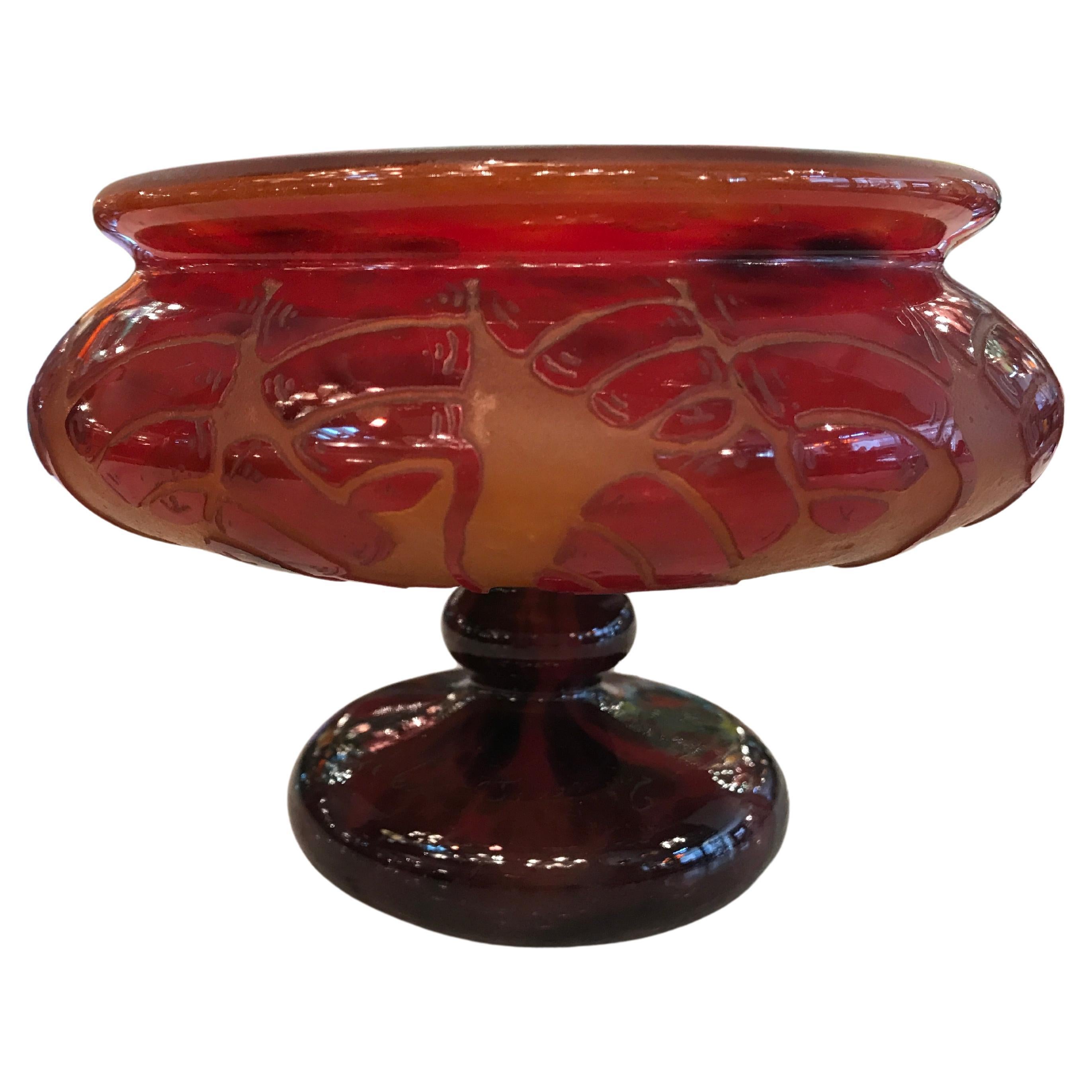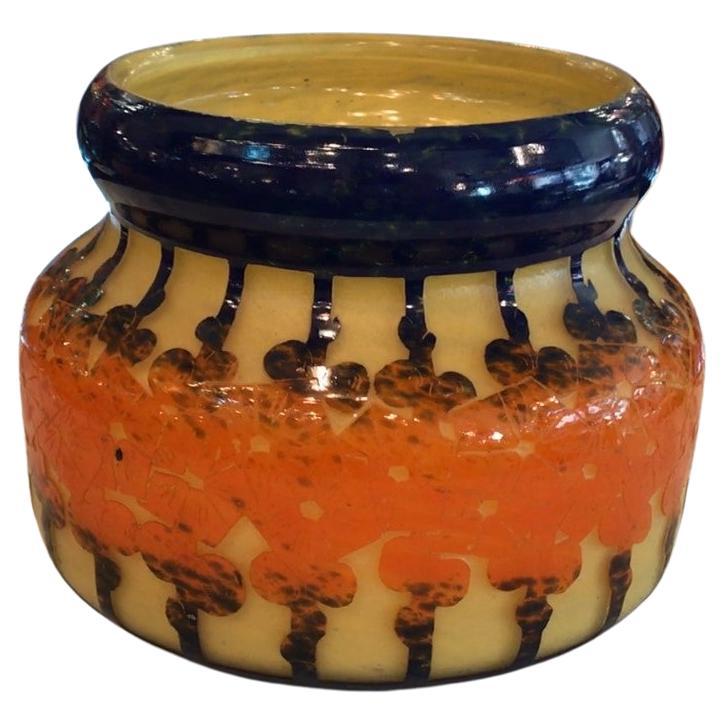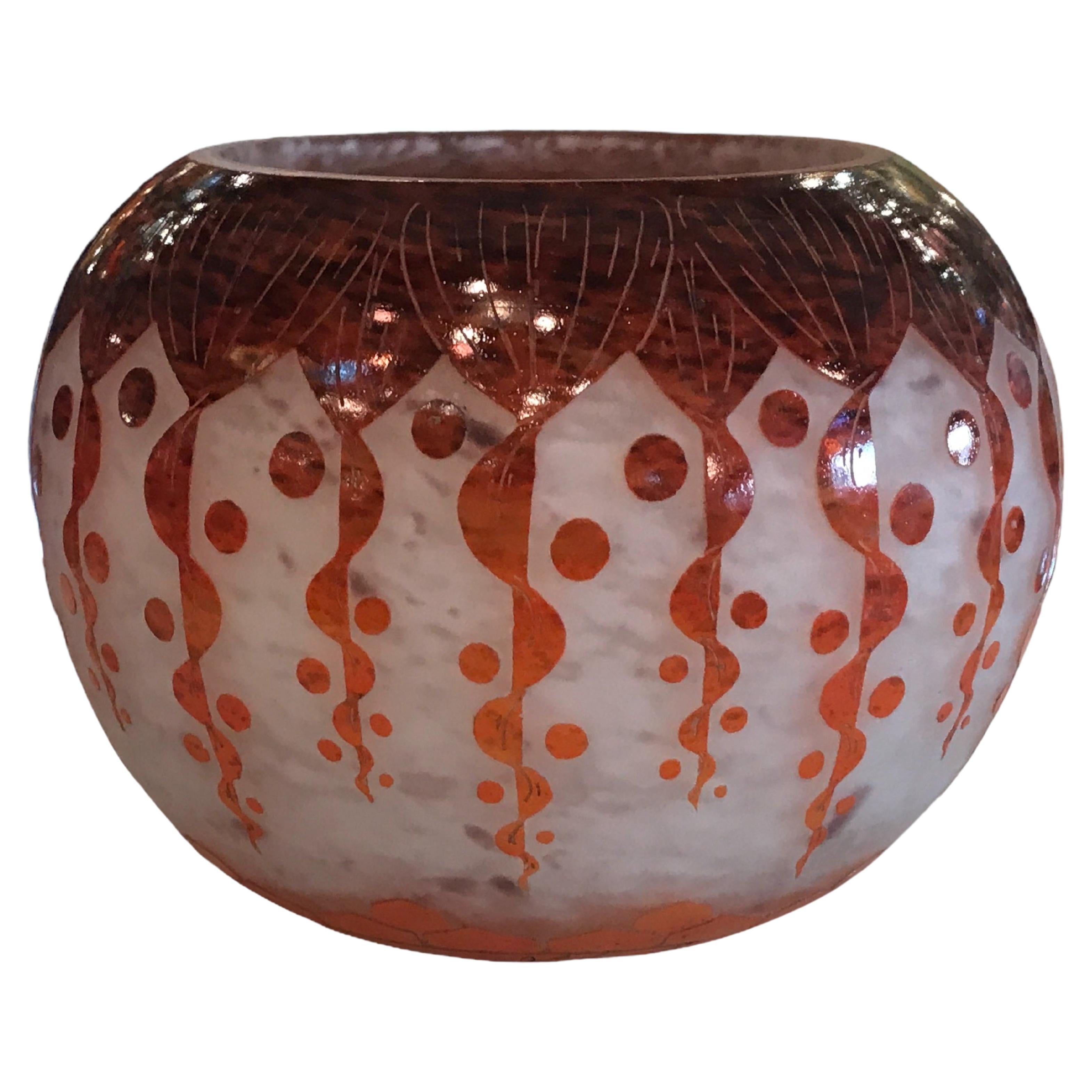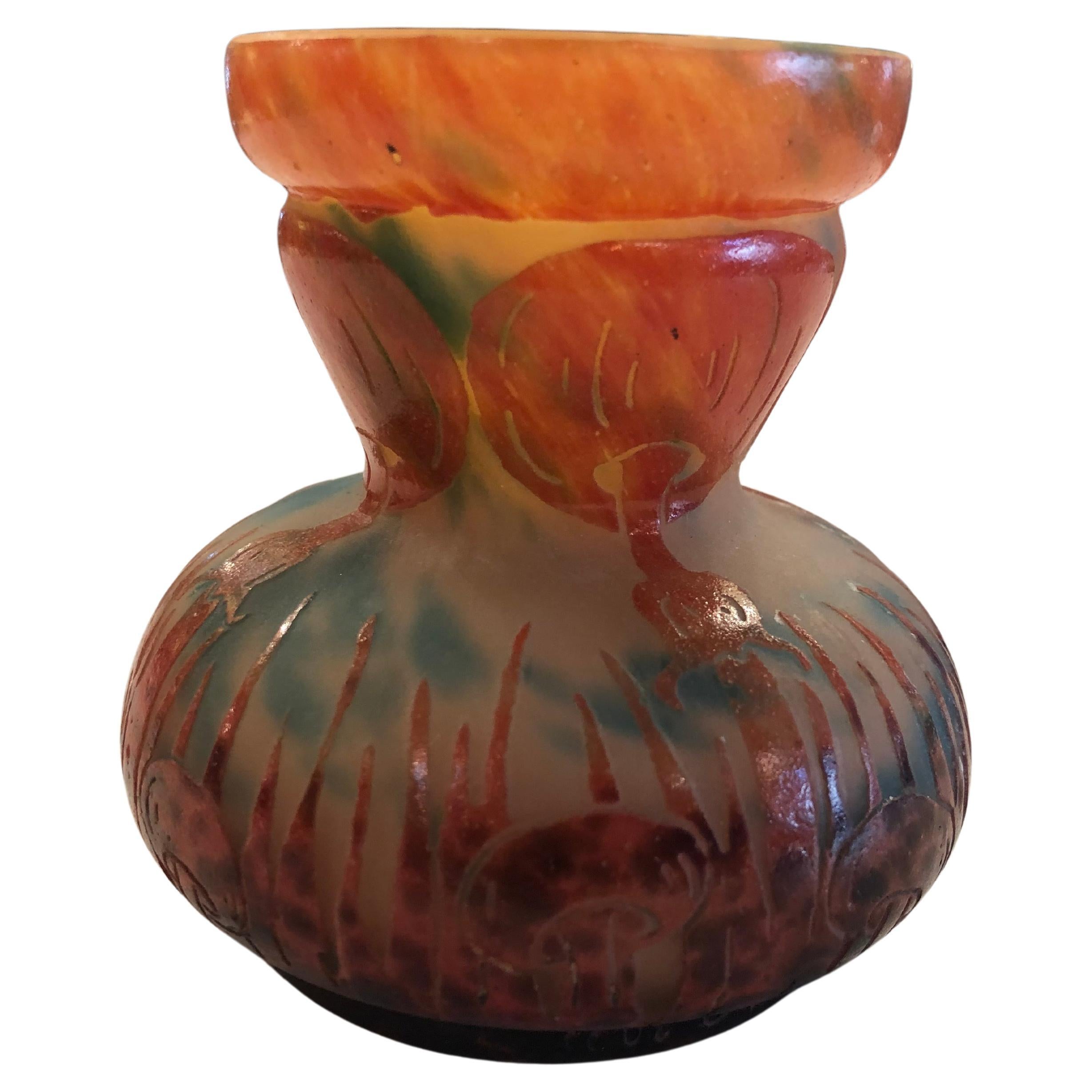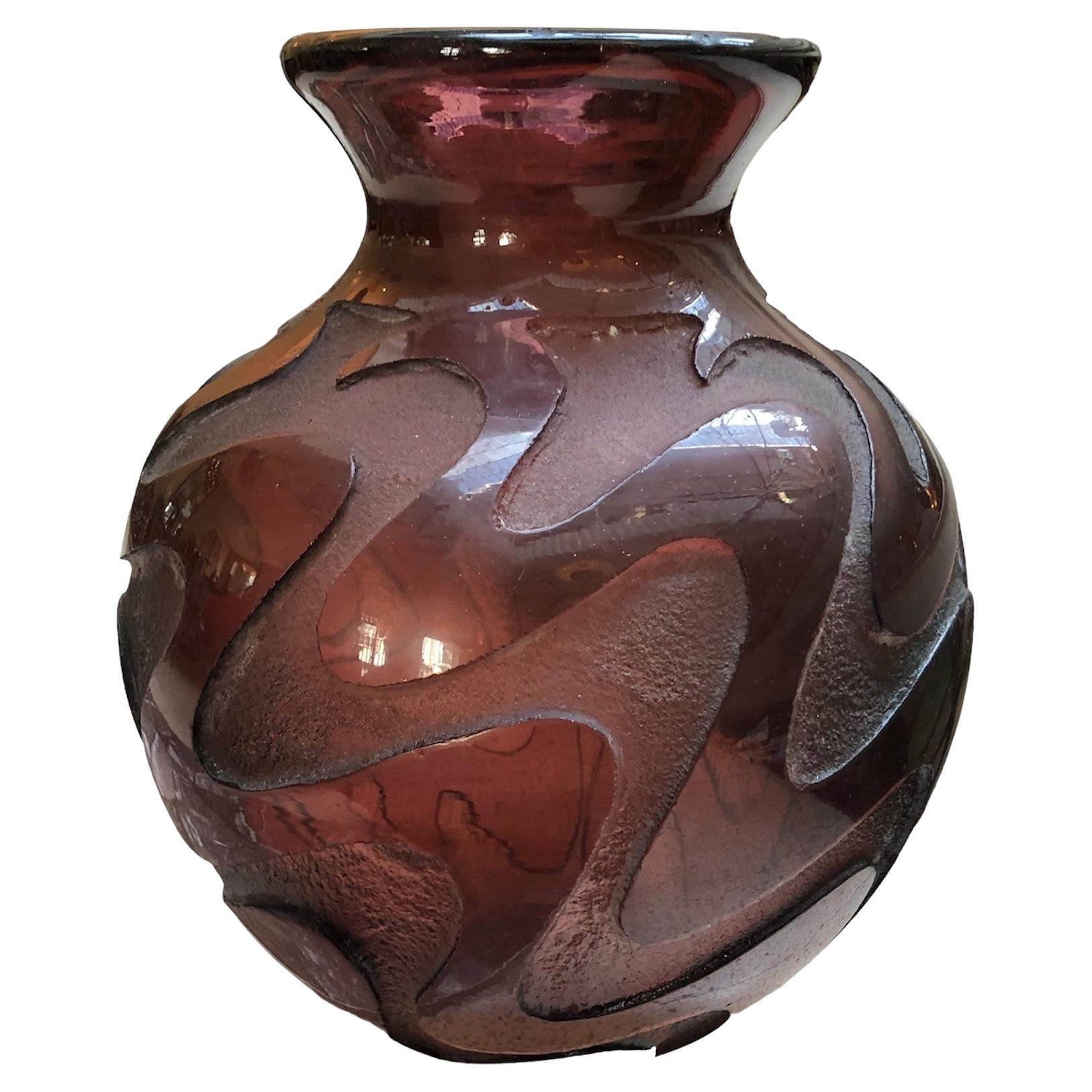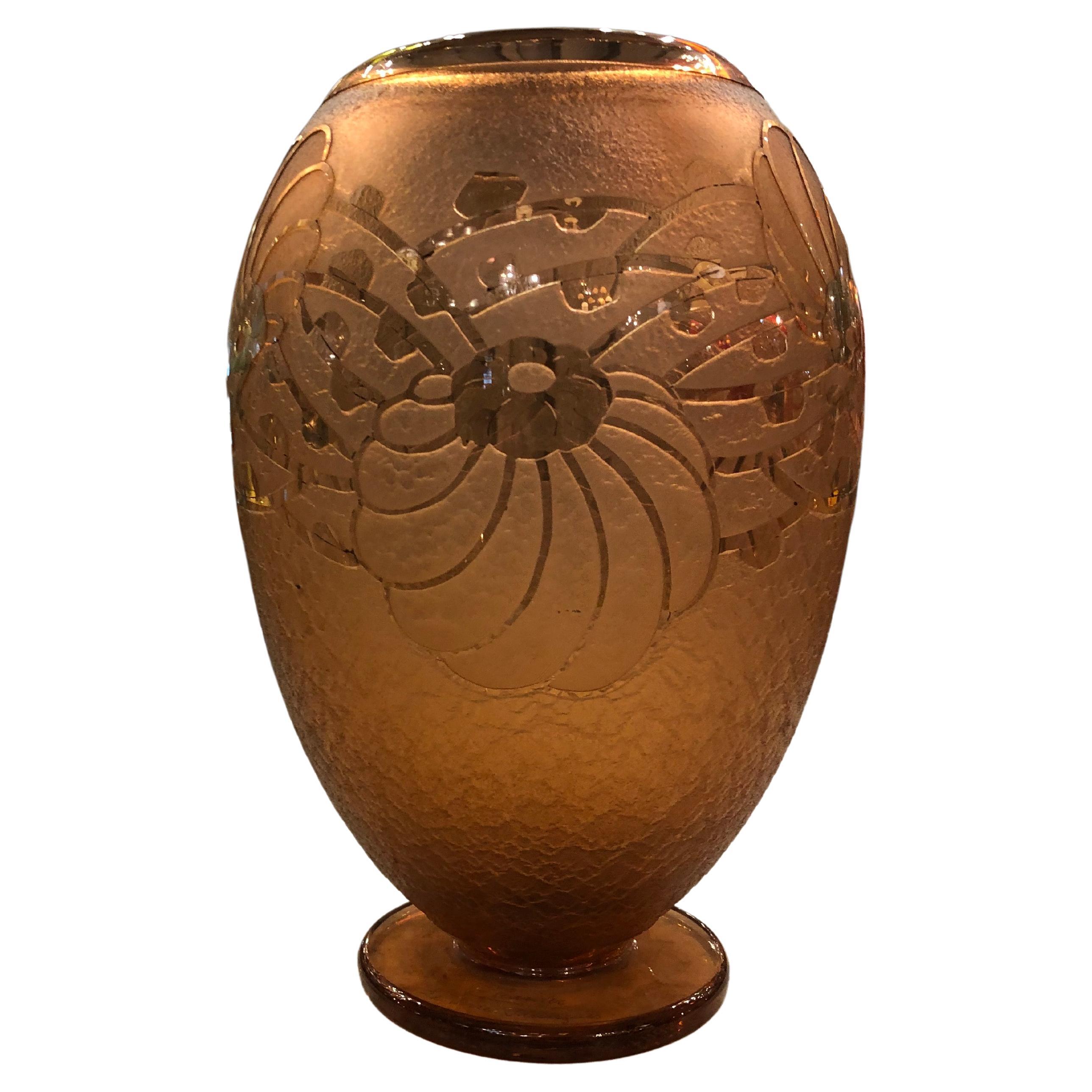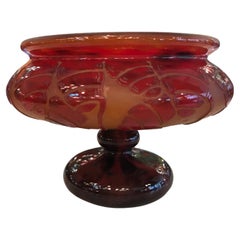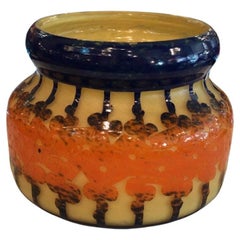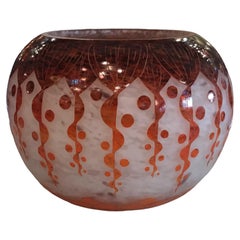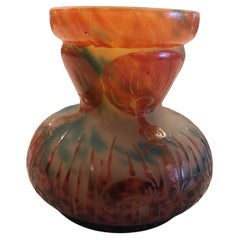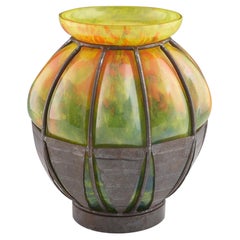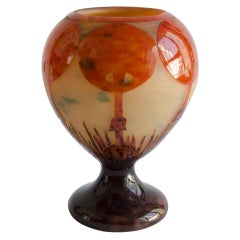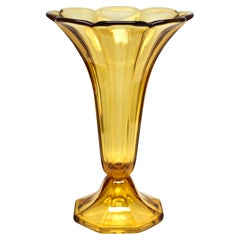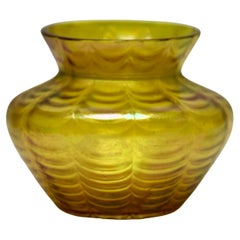Items Similar to Glass, Sign Marinot , Design; Georges Maurice Marinot, 1923
Want more images or videos?
Request additional images or videos from the seller
1 of 16
Glass, Sign Marinot , Design; Georges Maurice Marinot, 1923
$40,000
£30,235.04
€34,745.44
CA$55,699.75
A$61,963.69
CHF 32,482.14
MX$757,181.21
NOK 413,619.59
SEK 389,365.62
DKK 259,361.52
Shipping
Retrieving quote...The 1stDibs Promise:
Authenticity Guarantee,
Money-Back Guarantee,
24-Hour Cancellation
About the Item
Marinot's father was a bonnet maker. Maurice did poorly in school, but convinced his parents to send him to the École des Beaux-Arts in 1901 to train as a painter under French painter, Fernand Cormon. He left art school after his work wasn't accepted by the standards of the day. In 1905 he returned to Troyes, where he stayed for the rest of his life.
In 1911 he visited his first glass shop, owned by his friends, the Viard brothers, in Bar-sur-Seine. He fell in love with the contrasts between colors, hot and cold, the play of light and fire. He began designing bowls, vases and bottles which his friends made, then he painted enamels on the surface.
In 1912 he had his first exhibition and by 1913 critics were praising his work, saying “It has been a long time since an innovation of such great importance has come to enrich the art of glass” (Leon Rosenthal, Gazette des Beaux-Arts, 1913). From that year he stopped exhibiting his paintings.
The Viard brothers give Marinot his own bench and a set of tools, so he learned quickly how to blow glass. In 1923 he stopped using enamels, and explored the use of bubbles, metal leaf, and colored glass. His production process was “Long and fraught with danger” and one piece could take as long as a year to reach his standards.
The Viard Glassworks closed in 1937. Marinot was ill, and never touched glass again, though he did continue to paint. In the 1944 Allied bombing of Troyes there was direct hit on his studio, destroying over 2,500 paintings, thousands of drawings, and much of his glass. His sister's extensive collection was not damaged.
Major donation of Maurice Marinot (glass and paintings) was made by Pierre and Denise Levy to the Museum of Modern Art in Troyes in 1976. Florence, Marinot's daughter also gave major Maurice Marinot pieces of art to the city of Rennes Museum of Art.
A 20 piece glass collection by Marinot including vases, goblets and stoppered bottles dating to 1926-27 was gifted to the National Gallery of Ireland in 1970.
We have specialized in the sale of Art Deco and Art Nouveau and Vintage styles since 1982. If you have any questions we are at your disposal.
Pushing the button that reads 'View All From Seller'. And you can see more objects to the style for sale.
Why are there so many antiques in Argentina?
In the 1880 – 1940 there was a grate wave of immigration encouraged by the periods of war that were taking place.
1st World War took place between 1914 and 1918
2nd World War took place between 1939 and 1945
The immigrants options were New York or Buenos Aires. Tickets were cheap and in Buenos Aires they were welcomed with open arms, as it was a country where everything was still to be done.
Argentina was the country of new opportunities, labour was needed and religious freedom was assured, in many cases the of the family travel first until they were settled and then the rest of the family members join them.
In the immigrant museum “Ellis Island Immigrant Building” in New York you can se the promotional posters of the boats that would take them to a new life.
Between the years 1895 and 1896, Argentina had the highest DGP (gross domestic product) per capita in the world according to the Maddison Historical Statistics index, this situation arose due to the large amount of food being exported to European countries, which were at war.
The Argentinean ships left the port of Buenos Aires with food, but they returned with furniture, clothes and construction elements, (it´s common to see this the old buildings of the historic neighbourhood of San Telmo, the beams with the inscription “Made in England)”, as well as many markets that were built in Buenos Aires, such us the San Telmo Market, whose structure was brought by ship and afterwards assembled in 900 Defensa Street.
With the great influence of European immigrants living in the country, the children of the upper classes travelled to study in France, resulting in the inauguration of “La Maison Argentinienne”, on 27th of June 1928, in the international city of Paris, which hosted many Argentinians that were studying in Frace.
It´s the fourth house to be built after France, Canada and Belgium, being the first Spanish-speaking one. Still in place today (17 Bd Jourdan, 75014, Paris, France). Many of the children of these wealthy families who attended international art exhibitions, museums and art courses abroad, took a keen interest in the European style. This is why Buenos Aires was at the time referred as “The Paris of South America”.
Between the years 1890 and 1920 more than a hundred Palaces were built on Alvear Avenue the most exclusive avenue in Buenos Aires. Today some of these palaces have been transformed into museums, hotels and embassies.
In the year 1936, the Kavanagh building was inaugurated, it was the tallest reinforced concrete building in South America.
During 1994 the American Society of Civil Engineers distinguished it as an “international engineering milestone”, and it´s now considered a World Heritage of Modern Architecture.
At the time was common to hire foreign architects such as Le Corbusier, who visited Buenos Aires/Argentina in 1929 and in 1948 he drew up the blueprints for a house built in La Plata City (which was declared a World Heritage Site).
In 1947, the Hungarian architect Marcelo Breuer designed “Parador Ariston” in the seaside city of Mar del Plata. After an Argentinean student at Harvard University convinced him to come to Argentina. He worked on an urban development project in the Casa Amarilla, area of La Boca.
The Ukrainian architect, Vladimiro Acosta, arrives in Argentina in 1928 and worked as an architect until que moved to Brazil.
Antonio Bonet, a Spanish architect who worked with Le Corbusier in Paris, arrives in Argentina in 1937, where he carried out several architectural works and in 1938 designs the well-known BFK chair.
Andres Kálnay, of Hungarian origin, made around 120 architectural masterpieces, among which the former Munich brewery stands out, he even made the furniture’s design.
The German architect, Walter Gropius, director of the Bauhaus, lived in Argentina, where he wrote articles for “Sur” magazine and founded in Buenos Aires, an architectural firm with Franz Möller, who was also an architect, where he built two houses.
At the same time several famous designers decided to immigrate to Argentina, among them we can find the well-known French designer, Jean-Michel Frank, who arrived in the country in 1940 and also worked for the Rockefeller family.
Special pieces were made, which were sold exclusively in the country, such as the well-known German company “WMF”, who sold their products by catalogue, which were chosen by the ladies of high society in the list of wedding gifts, as well as the pieces designed by Christofle.
The Swiss sculptor Alberto Giacometti, made special pieces for Argentinean mansions.
In 1904 the first Jansen branch outside Paris was established in Buenos Aires, as the Argentinean clientele demanded a large amount of furniture, from the end of the 19th century to the mid-20th century.
In 1970, the brand Rigolleau Argentina made pieces authorised by Lalique.
The brands Maple and Thompson also set up shop in the country.
The French plastic artist, Marcel Duchamp moved to Argentina in 1918-1919.
Glass signed Gallé, Charder, Leverre, Schneider, Muller and other French firms. They were bought in flower shops and were given to ladies with beautiful floral arrangements.
Some furniture manufacturers travelled to international fairs and bough the patterns to produce the furniture in Argentina, such as the furniture firm Englander and Bonta, who bought the patterns ins Italy.
It is worth mentioning that in Argentina we have the largest community of Italians outside of Italy, as it is estimated that 70 percent of the inhabitants have at least one Italian descendant, followed by Spanish immigrants.
The most Important furniture stores in Argentina:
Comte is founded in 1934 (under the direct management of Jean Michel Frank in 1940).
Nordiska (Swedish company established in 1934).
Churba in 1960, a company that brought foreign designers to present their furniture in the country:
Denmark: (Arne Jacobsen, Finn Juhl, Bender Madsen, Ejner Larsen, Poul Kjaerholm, Hans Wegner)
Sweden: (Hans Agne Jakobsson, Gustavsberg)
United States: (Herman Miller)
Finland: (Lisa Johansson, Folke Arstrom, Tapio Wirkkala, Alvar Aalto, Timo Sarpaneva)
Swedish Factory: (Orrefors)
Italy: (Littala, Vico Magistretti, Emma Gismondi, Gae Aulenti, Angelo Mangiarotti, Elio Martinelli, Gianna Celada, Angelo Mangiarotti, Mario Bellini, Carlo Scarpa)
Finland: (Olivia Toikka)
Plata Lappas (Lappas Silver): a goldsmith shop founded in 1887 in Argentina by Alcibiades Lappas of Greek origin.
In 2019, in Argentina took place “the Art Deco world congress”, in which we participated as hosts invited by Geo Darder, founder of the Copperbridge – Foundation, in which prominent people from all over the world attended to learn about Art Deco in Argentina.
Argentina currently has more than 100 Art Deco buildings and another 90 Art Nouveau buildings throughout the city of Buenos Aires.
Argentina is a country that has not been involved in many wars, which is why it has been a refuge for works of art and antiques from different periods of time, unlike European countries. That is way many collectors, museums and antique dealers from all over the world visit it, you should not miss the opportunity to visit this great country.
Laura Guevara Kjuder, architect.
- Creator:Maurice Marinot (Designer)
- Dimensions:Height: 10.24 in (26 cm)Diameter: 8.67 in (22 cm)
- Style:Art Nouveau (Of the Period)
- Materials and Techniques:
- Place of Origin:
- Period:
- Date of Manufacture:1923
- Condition:Wear consistent with age and use.
- Seller Location:Ciudad Autónoma Buenos Aires, AR
- Reference Number:Seller: G-1stDibs: LU6785242293822
About the Seller
5.0
Vetted Professional Seller
Every seller passes strict standards for authenticity and reliability
Established in 1982
1stDibs seller since 2022
37 sales on 1stDibs
Typical response time: <1 hour
- ShippingRetrieving quote...Shipping from: Ciudad Autónoma Buenos Aires, Argentina
- Return Policy
Authenticity Guarantee
In the unlikely event there’s an issue with an item’s authenticity, contact us within 1 year for a full refund. DetailsMoney-Back Guarantee
If your item is not as described, is damaged in transit, or does not arrive, contact us within 7 days for a full refund. Details24-Hour Cancellation
You have a 24-hour grace period in which to reconsider your purchase, with no questions asked.Vetted Professional Sellers
Our world-class sellers must adhere to strict standards for service and quality, maintaining the integrity of our listings.Price-Match Guarantee
If you find that a seller listed the same item for a lower price elsewhere, we’ll match it.Trusted Global Delivery
Our best-in-class carrier network provides specialized shipping options worldwide, including custom delivery.More From This Seller
View AllVase , Sign: Le Verre Francais France, Style: Art Nouveau, 1924
By Le Verre Francais
Located in Ciudad Autónoma Buenos Aires, C
Vase Sign: Le Verre Francais
acid worked
Le Verre cameo glass was a separate line of art glass designed by Charles Schneider. Its production was made at the same time as the Schneid...
Category
Vintage 1920s French Art Nouveau Glass
Materials
Art Glass
Vase, Sign: Le Verre Francais ( Plant Mirettes / Peepers ), Style: Art Nouveau
By Le Verre Francais
Located in Ciudad Autónoma Buenos Aires, C
Vase Sign: Le Verre Francais
acid worked
Le Verre cameo glass was a separate line of art glass designed by Charles Schneider. Its production was made at the same time as the Schneid...
Category
Vintage 1920s French Art Nouveau Glass
Materials
Art Glass
Le Verre Francais ( Plant Rubaniers ) Style: Art Nouveau, Jugendstil
By Le Verre Francais
Located in Ciudad Autónoma Buenos Aires, C
Vase Le Verre Francais
acid worked
Le Verre cameo glass was a separate line of art glass designed by Charles Schneider. Its production was made at the same time as the Schneider des...
Category
Vintage 1920s French Art Nouveau Glass
Materials
Art Glass
Vase, Sign: Le Verre Francais (mushroom decoration), Style: Art Nouveau, Liberty
By Le Verre Francais
Located in Ciudad Autónoma Buenos Aires, C
Vase Le Verre Francais
acid worked
Le Verre cameo glass was a separate line of art glass designed by Charles Schneider. Its production was made at the same time as the Schneider des...
Category
Vintage 1910s French Art Nouveau Glass
Materials
Art Glass
Vase Sign: Degué, Made in France, 1926, Art Deco
By Degué
Located in Ciudad Autónoma Buenos Aires, C
Degue : David Guéron design Edouard Cazaux
David Gueron, Turkish and a former fighter of the French Foreign Legion, was the founder of the "Cristalleries De Compiegne". This glasswo...
Category
Vintage 1920s French Art Deco Glass
Materials
Glass
Vase Sign: Charder Le Verre Francais France
By Le Verre Francais
Located in Ciudad Autónoma Buenos Aires, C
Vase Sign: Charder Le Verre Francais France
Le Verre cameo glass was a separate line of art glass designed by Charles Schneider. Its production was made at the same time as the Schn...
Category
Vintage 1920s French Art Nouveau Glass
Materials
Art Glass
You May Also Like
Verrerie D'Art Lorraine Glass With Wrought Iron Frame c1925
By Daum, Louis Majorelle
Located in Tunbridge Wells, GB
Heading : A Verrrerie d'Art Lorrain vase with Majorelle type wrought metal mounts
Date : Circa 1925
Origin : Croismare, France
Bowl Features : Mottled citrus coloured glass blown int...
Category
Vintage 1920s French Art Nouveau Glass
Materials
Art Glass
Le Verre Francais, Caprins, Art Deco
By Le Verre Francais
Located in Buenos Aires, Argentina
Le verre Francais -caprins-
Art Deco period, circa 1920
perfect condition
artist Charles Schneider.
Charles Schneider was an Art Deco glass artist, ...
Category
Vintage 1920s French Art Deco Glass
Materials
Art Glass
$1,440 Sale Price
20% Off
Art Deco Val Saint Lambert, Luxval vase, Model Americain Charles Graffart, 1934
By Charles Graffart 1, Val Saint Lambert
Located in Verviers, BE
Val-Saint-Lambert - Luxval Art deco pressed glass "Americain" vase design Charles Graffart
Val Saint Lambert in their Luxval series, Americainin the 1930s. "VSL Belgique"
and is listed in the catalogue of Luxval of 1935,
Val Saint Lambert, Luxval, Art Deco.
During the 1930s, Val Saint-Lambert carried a product line-LUXVAL -of pressed decorative art deco glassware...
Category
Vintage 1930s Belgian Art Deco Glass
Materials
Glass
Loetz Art Nouveau vase whit Details of Irradiated glass 1900s
By Loetz Glass
Located in Verviers, BE
Beautifully decorated whit Irradiated glass
Rare to find with original condition
The piece is in good condition and a real beauty!
Photography fails to capture the simple elega...
Category
Antique Early 1900s French Art Nouveau Serving Bowls
Materials
Art Glass
Murano Glass Globet, 1930s
Located in Palermo, PA
Murano glass globet, 1930s.
Dimensions: H= 25 cm; D= 9 cm.
Category
Vintage 1930s Italian Mid-Century Modern Glass
Materials
Glass
Le Verre Francais Glass
By Le Verre Francais
Located in Buenos Aires, Argentina
Le Verre Francais glass
Art Deco Modelo uvas
Circa 1920 Origen Francia
Condicion perfecta Artista Charles Schneider.
Charles Schneider was an Art De...
Category
Vintage 1920s French Art Deco Glass
Materials
Art Glass
More Ways To Browse
Glass Art Waves
Artist Feller
End Of Day Glass
Large France Glass Bowls
Used School Furniture Canada
Used Stop Signs
1920 Deco Glass Bowls
Enamel Street Signs
Greek Bottle
19th Spanish Bowls
Antique Bombs
Antique End Of Day Glass
Antique Glass Bowls And Vases
Galle Bottles
Danish Painting 1920s
Antique Ships In Bottles
French Enamel Religious
Antique American Glass Bottles
